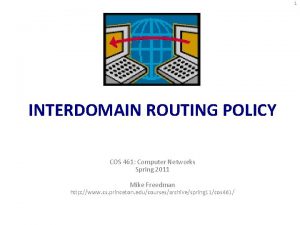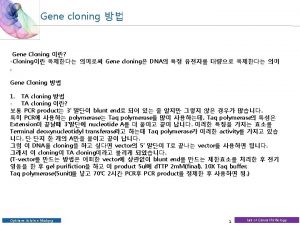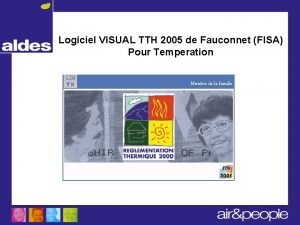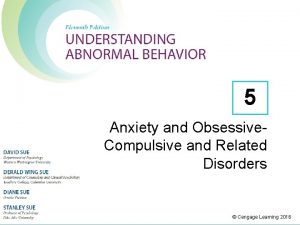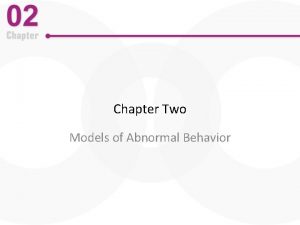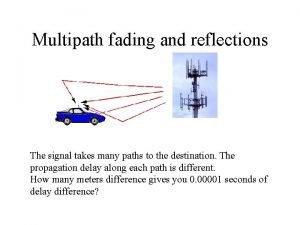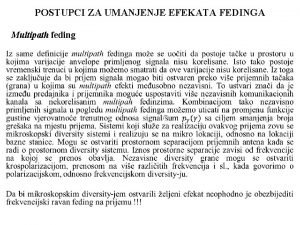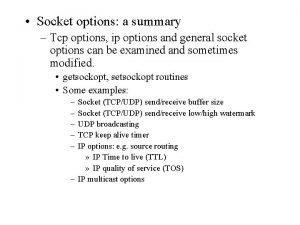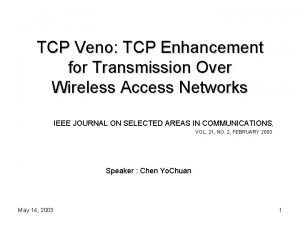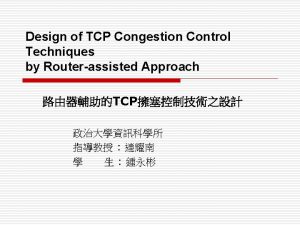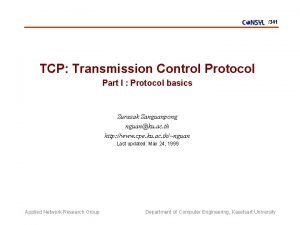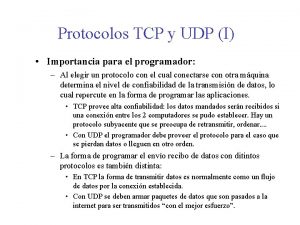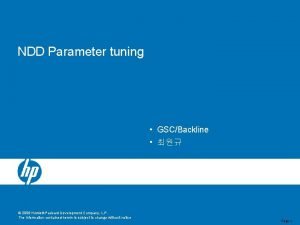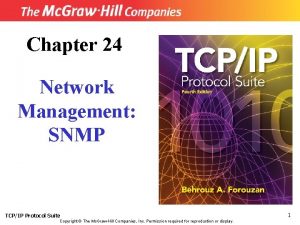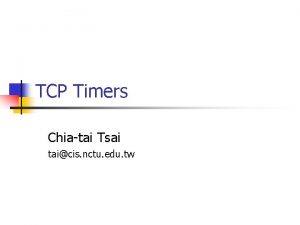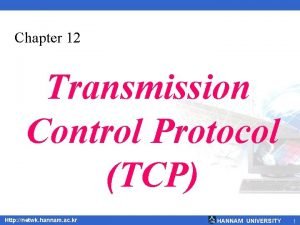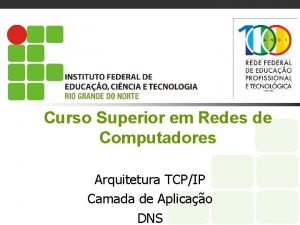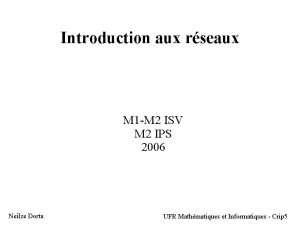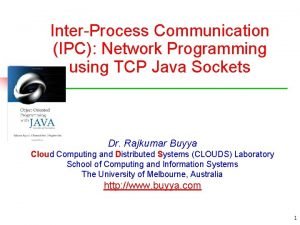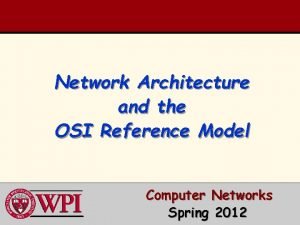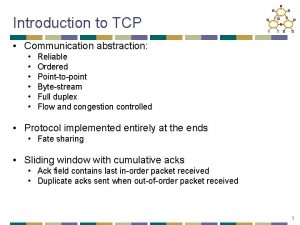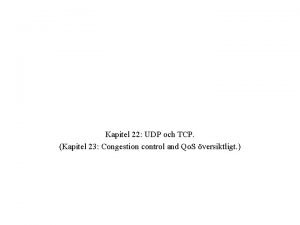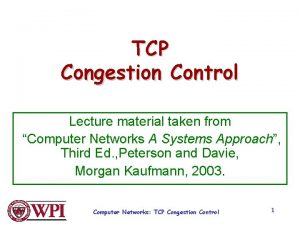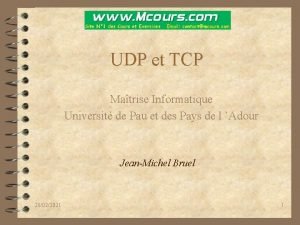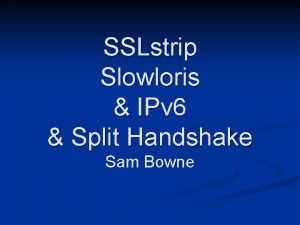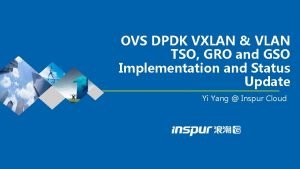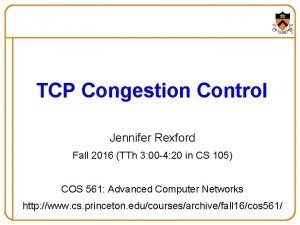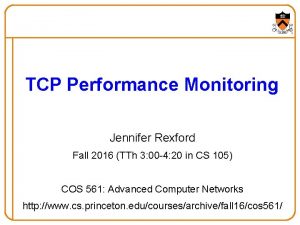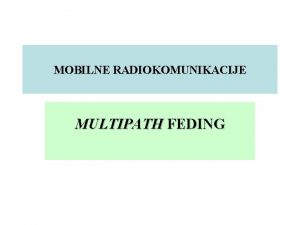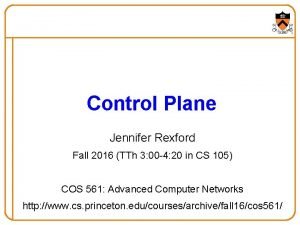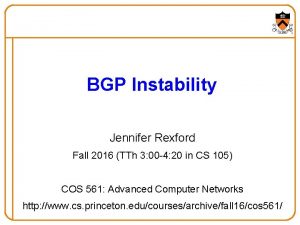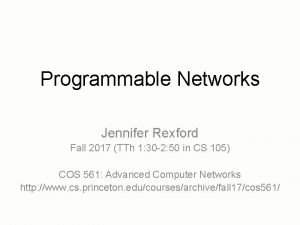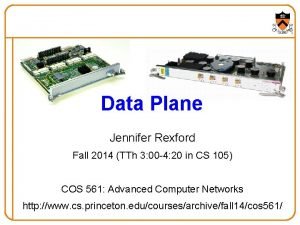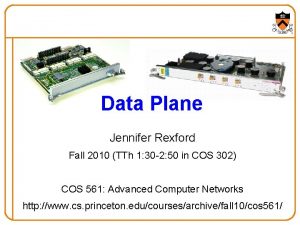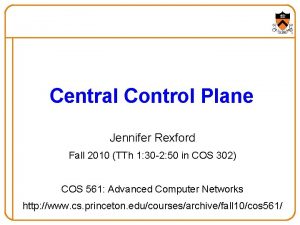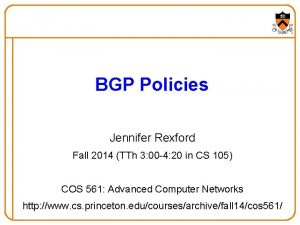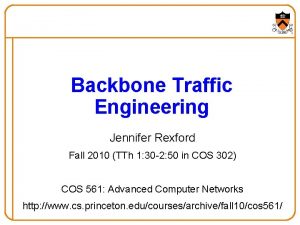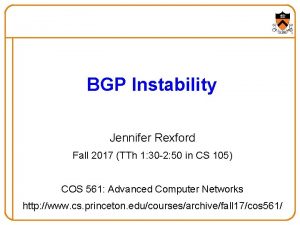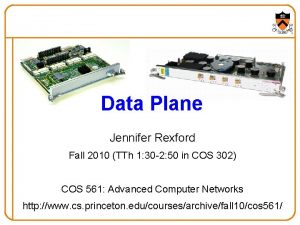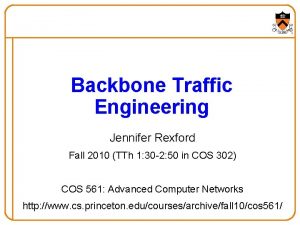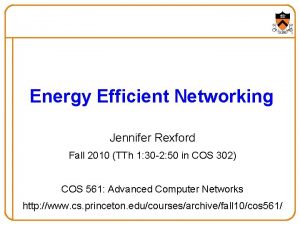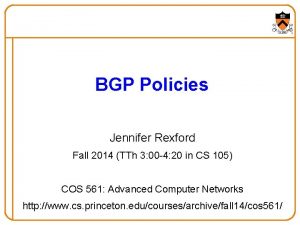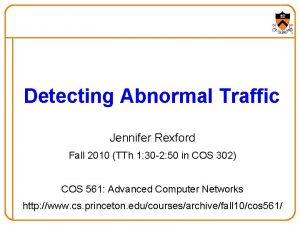Multipath TCP Jennifer Rexford Fall 2016 TTh 3








































- Slides: 40

Multipath TCP Jennifer Rexford Fall 2016 (TTh 3: 00 -4: 20 in CS 105) COS 561: Advanced Computer Networks http: //www. cs. princeton. edu/courses/archive/fall 16/cos 561/

Multipath • Mobile user – Wi. Fi and cellular at the same time • High-end servers – Multiple Ethernet cards • Data centers – Rich topologies with many paths • Benefits of multipath – Higher throughput – Failover from one path to another – Seamless mobility 2

Multipath TCP Protocol 3

Working With Unmodified Apps • Present the same socket API and expectations – Identified by the “five tuple” (IP address, port #, protocol) From http: //queue. acm. org/detail. cfm? id=2591369 4

Working With Unmodified Hosts • Establish the TCP connection in the normal way – Create a socket to a single remote IP address/port A SYN CK SYN A ACK B Each host tells its Initial Sequence Number (ISN) to the other host. Data • And then add more subflows, if possible 5

Negotiating MPTCP Capability • How do hosts know they both speak MPTCP? – During the 3 -way SYN/SYN-ACK/ACK handshake • If SYN-ACK doesn’t contain MP_CAPABLE – Don’t try to add any subflows! 6

Adding Subflows, Idealized • How to associate a new subflow with the connection? – Use a token generated from original subflow set-up • How to start using the new subflow? – Simply start sending packets with new IP/port pairs – … and associate them with the existing connection • How could two end-points learn about extra IP addresses for establishing new subflows? – Implicitly: one end-point establishes a new subflow, to already-known address(es) at the other end-point 7

Sequence Numbers • Challenges across subflows – Out-of-order packets due to RTT differences – Access networks that rewrite sequence numbers – Middleboxes upset by discontinuous TCP byte stream – Need to retransmit lost packets on a different subflow • Two levels of sequence numbers – Sequence numbers per subflow – Sequence numbers for the entire connection • Enables – Efficient detection of loss on each subflow – Retransmission of lost packet on a different subflow 8

Receive Buffer Space • Each TCP connection has a receive buffer – Buffer space to store incoming data – … until it is read by the application • TCP flow control – Receiver advertises the available buffer space – … using the “receive window” • Should each subflow have its own receive window? – Starvation of some subflows in a connection? – Fairness relative to other TCP connections? – Fragmentation of the available buffer space? • Instead, use a common receive window 9

Fairness and Efficiency in Multipath Congestion Control Slides from Damon Wischik 10

Goal #1: Fairness at Shared Bottlenecks A multipath TCP flow with two subflows Regular TCP To be fair, Multipath TCP should take as much capacity as TCP at a bottleneck link, no matter how many paths it is using. 11

Goal #2: Use Efficient Paths 12 Mb/s Each flow has a choice of a 1 -hop and a 2 -hop path. How should split its traffic? 12

Use Efficient Paths 12 Mb/s 8 Mb/s 12 Mb/ s 8 Mb/s If each flow split its traffic 1: 1. . . 13

Use Efficient Paths 12 Mb/s 9 Mb/s 12 Mb/s If each flow split its traffic 2: 1. . . 12 Mb/s 9 Mb/s 14

Use Efficient Paths 12 Mb/s 12 Mb/s Better: Each connection on a one-hop path Each connection should send all traffic on the leastcongested paths 15

Use Efficient Paths 12 Mb/s 12 Mb/s Better: Each connection on a one-hop path Each connection should send all traffic on the leastcongested paths But keep some traffic on the alternate paths as a probe 16

Goal #3: Be Fair Compared to TCP • Least-congested paths may not be best! – Due to differences in round-trip time • Two paths – Wi. Fi: high loss, low RTT – Cellular: low loss, high RTT • Using the least-congested path – Choose the cellular path, due to low loss – But, the RTT is high – So throughput is low! 17

Be Fair Compared to TCP • To be fair, Multipath TCP should give a connection at least as much throughput as it would get with a single-path TCP on the best of its paths. – Ensure incentive for deploying MPTCP • A Multipath TCP should take no more capacity on any path (or collection of paths) than if it was a single-path TCP flow using the best of those paths. – Do no harm! 18

Achieving These Goals • Regular TCP – Maintain a congestion window w – On an ACK, increase by 1/w (increase 1 per window) – On a loss, decrease by w/2 • MPTCP – Maintain a congestion window per path wr – On an ACK on path r, increase wr – On a loss on path r, decrease by wr/2 • How much to increase wr on an ACK? ? – If r is the only path at that bottleneck, increase by 1/wr 19

If Multiple Paths Share Bottleneck? • Don’t take any more bandwidth on a link than the best of the TCP paths would – But, where might the bottlenecks be? – Multiple paths might share the same bottleneck • So, consider all possible subsets of the paths – Set R of paths – Subset S of R that includes path r • E. g. , consider path 3 – Suppose paths 1, 3, and 4 share a bottleneck – … but, path 2 does not – Then, we care about S = {1, 3, 4} 20

Achieving These Goals • What is the best of these subflows achieving? – Path s is achieving throughput of ws/RTTs – So best path is getting maxs(ws/RTTs) • What total bandwidth are these subflows getting? – Across all subflows sharing that bottleneck – Sum over s in S of ws/RTTs • Consider the ratio of the two – Increase by less if many subflows are sharing • And pick the results for the set S with min ratio – To account for the most paths sharing a bottleneck 21

Incremental Deployment Challenges of Middleboxes 22

Middleboxes • In-network services, e. g. , – Firewall – Network address translator – Transparent proxy – Intrusion detection system • Interaction with TCP – Change IP addresses and port numbers – Change TCP initial sequence number – Remove TCP options – Dividing large block of data into smaller packets – Expect to see all packets of the connection – Etc. 23

Negotiating MPTCP Capability • What if middleboxes strip the TCP option? – On the SYN? On the SYN-ACK? • Include capability on the ACK of the SYN-ACK? – What if the ACK is lost? – Carry on all subsequent packets • What if the middlebox drops SYN packets with unfamiliar options? – Sender can retransmit lost SYN without the option – … and fall back to regular TCP behavior 24

Challenges: NAT • Network Address Translators (NAT) – Problem: NAT changes the IP address and port number Wi. Fi LTE NAT 1 NAT 2 • How to identify a connection? – Using a token established during connection set-up • How to establish new subflows? – Allow one end-point to tell another about its addresses 25

Challenges: Security • Security – Malicious parties creating subflows – To highjack (part of) the connection • How to bootstrap security? – Include a random key during connection set-up – … and use it to verify authenticity of new subflows • How to identify the connection on new subflows? – A token generated from the key • How to authenticate the addition of subflows? – Exchanging nonces and computing message authentication codes using the keys 26

Use of Multipath TCP in i. OS 7 • Multipath TCP in i. OS 7 (fall 2013) – Primary TCP connection over Wi. Fi – Backup TCP connection over cellular data • Failover – If Wi. Fi becomes unavailable… – … i. OS 7 will use the cellular data connection • For destinations controlled by Apple – E. g. , Siri • See https: //support. apple. com/en-us/HT 201373 27

Discussion 28

Backup Slides: Review of TCP Protocol 29

Establishing a TCP Connection A B SYN C SYN A K ACK Each host tells its Initial Sequence Number (ISN) to the other host. Data • Three-way handshake to establish connection – Host A sends a SYN (open) to the host B – Host B returns a SYN acknowledgment (SYN ACK) – Host A sends an ACK to acknowledge the SYN ACK 30

Initial Sequence Number (ISN) • Sequence number for the very first byte – E. g. , Why not a de facto ISN of 0? • Practical issue: reuse of port numbers – Port numbers must (eventually) get used again – … and an old packet may still be in flight – … and associated with the new connection • Security issue: adversary injecting packets – Adversary may try to inject packets in a connection – … by guessing the Initial Sequence Number – … to send counterfeit packets to the receiving host – … e. g. , counterfeit packets that reset the connection – Some firewalls change the ISN to further randomize 31

Step 1: A’s Initial SYN Packet A’s port B’s port A’s Initial Sequence Number Flags: SYN FIN RST PSH URG ACK Acknowledgment 20 Flags 0 Checksum Advertised window Urgent pointer Options (variable) A tells B it wants to open a connection… 32

Step 2: B’s SYN-ACK Packet B’s port A’s port B’s Initial Sequence Number Flags: SYN FIN RST PSH URG ACK A’s ISN plus 1 20 Flags 0 Checksum Advertised window Urgent pointer Options (variable) B tells A it accepts, and is ready to hear the next byte… … upon receiving this packet, A can start sending data 33

Step 3: A’s ACK of the SYN-ACK A’s port B’s port Sequence number Flags: SYN FIN RST PSH URG ACK B’s ISN plus 1 20 Flags 0 Checksum Advertised window Urgent pointer Options (variable) A tells B it is okay to start sending … upon receiving this packet, B can start sending data 34

Sequence Number Host A ISN (initial sequence number) Byte 81 Sequence number = 1 st byte Host B TCP Data 35

TCP Header Source port Destination port Sequence number Flags: SYN FIN RST PSH URG ACK Acknowledgment Hdr. Len 0 Flags Advertised window Checksum Urgent pointer Options (variable) Data 36

Receive Buffering: Flow Control • Receive window size – Amount that can be sent without acknowledgment – Receiver must be able to store this amount of data • Receiver tells the sender the window – Tells the sender the amount of free space left Window Size Data ACK’d Outstanding Un-ack’d data Data OK to send Data not OK to send yet 37

TCP Header: Receive Window Source port Destination port Sequence number Flags: SYN FIN RST PSH URG ACK Acknowledgment Hdr. Len 0 Flags Advertised window Checksum Urgent pointer Options (variable) Data 38

Tearing Down the Connection ACK FIN Data ACK FIN ACK CK A SYN B time • Closing (each end of) the connection – Finish (FIN) to close and receive remaining bytes – And other host sends a FIN ACK to acknowledge – Reset (RST) to close and not receive remaining bytes 39

Extending TCP: TCP Options • TCP header – Ten mandatory fields – Optional extension field (usually during handshake) • Examples – Maximum segment size (MSS) – Window scaling – Support for Selected ACKs But, some middleboxes: (i) • Unknown options – Ignored by receiving host strip TCP options from some packets or (ii) drop packets with TCP options • Routers and TCP options – Should ignore them, passing them through unchanged 40
 Assembly language instruction
Assembly language instruction Gao rexford conditions
Gao rexford conditions Tth polymerase rtpcr
Tth polymerase rtpcr Températion
Températion Tavoitervio
Tavoitervio Tth szavak
Tth szavak Tth 550
Tth 550 Tth
Tth Multipath
Multipath Multipath model of anxiety disorders
Multipath model of anxiety disorders One dimensional model psychology
One dimensional model psychology Multipath reflection
Multipath reflection Multipath
Multipath Free fall 2016
Free fall 2016 So_rcvlowat
So_rcvlowat Tcp veno
Tcp veno New reno tcp
New reno tcp Purpose of tcp
Purpose of tcp Tcp state diagram
Tcp state diagram Cis tcp fin services
Cis tcp fin services Tcp cyfair
Tcp cyfair Protocolos tcp
Protocolos tcp Tcp tuning
Tcp tuning Transport layer in tcp/ip
Transport layer in tcp/ip Snmp uses two other protocols and
Snmp uses two other protocols and Tcp ip 프로토콜
Tcp ip 프로토콜 Tcp tw
Tcp tw Iso/osi
Iso/osi Tcp flow control diagram
Tcp flow control diagram Arquitetura tcp-ip
Arquitetura tcp-ip Dorta neilze
Dorta neilze Java interprocess communication
Java interprocess communication Osi network architecture
Osi network architecture How is tcp an abstraction
How is tcp an abstraction Udp 23
Udp 23 Tcp reno fast recovery
Tcp reno fast recovery Ghandover
Ghandover Tcp pau
Tcp pau Tcp.split.handshake
Tcp.split.handshake Tx-udp_tnl-segmentation
Tx-udp_tnl-segmentation Mdt tcp
Mdt tcp

